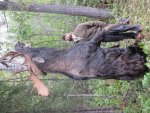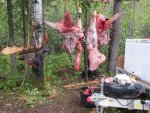Kevin Dill
WKR
- Joined
- Aug 26, 2014
- Messages
- 3,158
If you bring block and tackle (I call it a pulley system) be sure your rope is sufficiently stout. It takes a substantial amount of linear pull/poundage to break friction and then move a bulky moose uphill out of water, or pull him out of a bad spot. My 2016 bull came within 6' of rolling into a narrow little gulch about 4' deep and 6' wide. If he had ended up in there I would have worked double-hard to butcher him alone. I doubt I could have pulled him out of there by myself even with dyneema rope and a 4-way set of pulleys.
Harry Callahan: "A man's gotta know his limitations". Dirty Harry must have been a moose hunter, because that is perfect advice. I admit I'm getting more and more about responsible moose killing as I age. Gone is the need to march into Hell and kill the biggest moose I can find...then navigate him out of there regardless of personal suffering, injury or hardship. You can't control an injured moose of course. You can control how far you'll go to kill one and what kind of terrain you'll hunt in...given the limitations of having only your legs and backs for recovery. Moose and water are like peas and carrots...they go together. Still, I don't have a lot of interest in chasing moose in extremely wet settings where it seems like high odds a dead moose will find a watery grave.
I also think a most basic strategy for the guys who must backpack out all their meat (in a tough setting) is to go with more bags of meat weighing less per bag. I usually end up with 10 bags of meat but 12 might be better if the distance is far...intervening terrain is bad...or the packer just has physical issues to consider. Age is a physical issue by the way, lol.
Harry Callahan: "A man's gotta know his limitations". Dirty Harry must have been a moose hunter, because that is perfect advice. I admit I'm getting more and more about responsible moose killing as I age. Gone is the need to march into Hell and kill the biggest moose I can find...then navigate him out of there regardless of personal suffering, injury or hardship. You can't control an injured moose of course. You can control how far you'll go to kill one and what kind of terrain you'll hunt in...given the limitations of having only your legs and backs for recovery. Moose and water are like peas and carrots...they go together. Still, I don't have a lot of interest in chasing moose in extremely wet settings where it seems like high odds a dead moose will find a watery grave.
I also think a most basic strategy for the guys who must backpack out all their meat (in a tough setting) is to go with more bags of meat weighing less per bag. I usually end up with 10 bags of meat but 12 might be better if the distance is far...intervening terrain is bad...or the packer just has physical issues to consider. Age is a physical issue by the way, lol.


